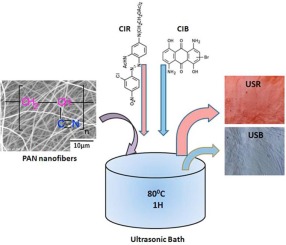Ultrasonics Sonochemistry ( IF 8.4 ) Pub Date : 2018-08-03 , DOI: 10.1016/j.ultsonch.2018.07.035 Abdul Wahab Jatoi , Pardeep Kumar Gianchandani , Ick Soo Kim , Qing-Qing Ni

|
We present our research on dyeability of polyacrylonitrile (PAN) nanofibers following ultrasonic dyeing method. Although PAN has been extensively utilized in textile apparel, sportswear, upholstery and home furnishing, however, coloration of PAN nanofibers has not yet been reported. PAN is a compact fiber while the nanofiber structure makes it more difficult to color PAN nanofibers. PAN is generally dyed with basic dyes and dyeing is carried out in acidic conditions, while the dyeing process takes about two hours at boiling temperature. A systematic study on dyeability of PAN nanofibers will extend its use in textile apparel industry. Thus, we used ultrasonic energy and first time conducted our research on dyeability of electrospun PAN nanofibers using disperse dyes. Dyeing process parameters such as dyeing time, temperatures and concentrations of dyes were optimized. Ultrasonic dyeing of PAN nanofibers was compared with its conventional dyeing as well. Affect of ultrasonic dyeing on the morphology, chemical state, crystallographic structure and mechanical strength of PAN nanofibers has been studied. PAN nanofiber samples were characterized by SEM, FTIR, XRD and tensile strength tests. The results revealed 80 °C and 60 min as optimum temperature and time for ultrasonic dyeing of PAN nanofibers. The ultrasonic dyeing does not affect morphology, chemical and crystalline structure of the PAN nanofibers while it improves their mechanical strength. Our research suggests dyeability of PAN nanofibers with disperse dyes by ultrasonic method and their subsequent use in textile apparels.
中文翻译:

超声诱导致密聚丙烯腈(PAN)纳米纤维着色的有效方法
我们介绍我们对聚丙烯腈(PAN)纳米纤维的超声染色方法的可染性的研究。尽管PAN已广泛用于纺织服装,运动服,室内装潢和家居装饰中,但是,尚未报道PAN纳米纤维的着色。PAN是一种紧密的纤维,而纳米纤维的结构使PAN纳米纤维的着色更加困难。PAN通常用碱性染料染色,并且染色在酸性条件下进行,而染色过程在沸腾温度下大约需要两个小时。对PAN纳米纤维的可染性的系统研究将扩展其在纺织服装行业中的应用。因此,我们使用了超声波能量,并首次对使用分散染料的电纺PAN纳米纤维的可染性进行了研究。染色工艺参数,例如染色时间,优化了温度和染料浓度。PAN纳米纤维的超声染色也与常规染色进行了比较。研究了超声染色对PAN纳米纤维的形貌,化学状态,晶体结构和机械强度的影响。通过SEM,FTIR,XRD和拉伸强度测试对PAN纳米纤维样品进行了表征。结果表明,将PAN纳米纤维超声染色的最佳温度和时间为80°C和60分钟。超声染色不会影响PAN纳米纤维的形态,化学和晶体结构,同时会提高其机械强度。我们的研究表明,PAN纳米纤维可通过超声方法与分散染料一起染色,并随后用于纺织服装。PAN纳米纤维的超声染色也与常规染色进行了比较。研究了超声染色对PAN纳米纤维的形貌,化学状态,晶体结构和机械强度的影响。通过SEM,FTIR,XRD和拉伸强度测试对PAN纳米纤维样品进行了表征。结果表明,将PAN纳米纤维超声染色的最佳温度和时间为80°C和60分钟。超声染色不会影响PAN纳米纤维的形态,化学和晶体结构,同时会提高其机械强度。我们的研究表明,PAN纳米纤维可通过超声方法与分散染料一起染色,并随后用于纺织服装。PAN纳米纤维的超声染色也与常规染色进行了比较。研究了超声染色对PAN纳米纤维的形貌,化学状态,晶体结构和机械强度的影响。通过SEM,FTIR,XRD和拉伸强度测试对PAN纳米纤维样品进行了表征。结果表明,将PAN纳米纤维超声染色的最佳温度和时间为80°C和60分钟。超声染色不会影响PAN纳米纤维的形态,化学和晶体结构,同时会提高其机械强度。我们的研究表明,PAN纳米纤维可通过超声方法与分散染料一起染色,并随后用于纺织服装。研究了PAN纳米纤维的晶体结构和机械强度。通过SEM,FTIR,XRD和拉伸强度测试对PAN纳米纤维样品进行了表征。结果表明,将PAN纳米纤维超声染色的最佳温度和时间为80°C和60分钟。超声染色不会影响PAN纳米纤维的形态,化学和晶体结构,同时会提高其机械强度。我们的研究表明,PAN纳米纤维可通过超声方法与分散染料一起染色,并随后用于纺织服装。研究了PAN纳米纤维的晶体结构和机械强度。通过SEM,FTIR,XRD和拉伸强度测试对PAN纳米纤维样品进行了表征。结果表明,将PAN纳米纤维超声染色的最佳温度和时间为80°C和60分钟。超声染色不会影响PAN纳米纤维的形态,化学和晶体结构,同时会提高其机械强度。我们的研究表明,PAN纳米纤维可通过超声方法与分散染料一起染色,并随后用于纺织服装。超声染色不会影响PAN纳米纤维的形态,化学和晶体结构,同时会提高其机械强度。我们的研究表明,PAN纳米纤维可通过超声方法与分散染料一起染色,并随后用于纺织服装。超声染色不会影响PAN纳米纤维的形态,化学和晶体结构,同时会提高其机械强度。我们的研究表明,PAN纳米纤维可通过超声方法与分散染料一起染色,并随后用于纺织服装。



























 京公网安备 11010802027423号
京公网安备 11010802027423号